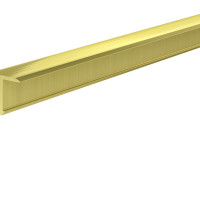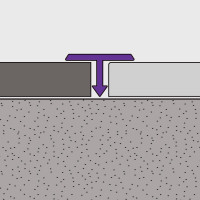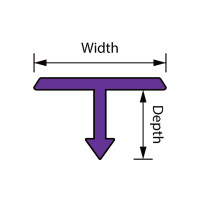
You need pdf software to read these documents. Download Adobe reader for free by clicking the icon on the left.
An brass profile for covering transitional joints. Retrofitted to adjoin different floor coverings of the same height.
This item is available in the following sizes
| Length : 2.5m | Product Code | |
|---|---|---|
| 16x8mm |  |
JCB160 |

You need pdf software to read these documents. Download Adobe reader for free by clicking the icon on the left.
Brass is a metal alloy made of copper and zinc; the proportions of zinc and copper can be varied to create a range of brasses with varying properties.
Atrim manufacture a range of Brass profiles for protecting and finishing tiled corners and edges.
Recommended for use where there is a heavy level of wear or a high level of protection is required.
Atrim Straight Edge Profiles feature a perforated anchoring leg for securing in adhesive or mortar bond below the tiled surface.
Atrim profiles need to be checked at point of specification, for suitability of application in any given area. Chemical reaction, intermetallic corrosion and mechanical stresses must all be taken into consideration.
Brass is used for decoration for its bright gold-like appearance. Brass can sustain high mechanical stresses and is resistant to some chemical exposure. In contact with air, solid brass will oxidize and develop a natural patina. This oxidation can be cleaned with a suitable polishing agent.
Brass has higher malleability than bronze or zinc. The relatively low melting point of brass (900 to 940 °C) and its flow characteristics make it a relatively easy material to cast. By varying the proportions of copper and zinc, the properties of the brass can be changed, allowing hard and soft brasses.
The bactericidal properties of brass have been observed for centuries. It is the copper in brass that makes brass germicidal. Depending upon the type and concentration of pathogens and the medium they are in, brass kills these microorganisms within a few minutes to hours of contact. A large number of independent studies confirm this antimicrobial effect, even against antibiotic-resistant bacteria such as MRSA and VRSA.
Types of Brass
There are a huge variation of types of brass, which are produced through different combinations of copper and zinc, and the addition of other metals, such as tin or lead, to change the properties of the metal.
Due to it’s properties, brass tiling trim is suitable for domestic, commercial and industrial use.
Maintenance
Almost all brass tends to oxidize (tarnish) quickly when exposed to air.To maintain optimum appearance, the surface should be cared for regularly. To polish solid brass, all you need to do is give the solid brass a simple wash with soapy water, let it dry, and apply the polish. Most conventional polishes will coat the raw metal with a thin film of oil to help inhibit future tarnishing. Additionally, most metal polishes contain solvents and detergents to remove the tarnish, mild abrasives to polish the metal, and oils to act as a barrier between the raw metal and air.
Don’t overdo it with the polish – more polish creates a smudging problem since fingerprints and the trace human body oils that are transferred anytime you handle an item “dissolve” the solvency of the metal polish. Additionally, too much polish may discolor the surface. Brass can sometimes turn “black” when cleaning due to overuse or misuse of polish.
During installation
The quality of installation affects the durability and lifespan of brass. Therefore, it is important to make sure brass is in good condition before installation. Normally, giving it a quick clean is enough prior to installation.
Routine maintenance
Maintenance is required to maintain the quality and appearance of steel. Depending on the environment, it is carried out between one and ten times per year. A proper maintenance routine significantly prolongs the life of brass.
Maintenance tools
Abrasive cleaning tools should be avoided to prevent alteration of brass finishes. Chloride-containing solutions, such as bleach, should also be avoided.
• Soft cloth and water: suitable for cosmetic issues and general cleaning
• Mild detergent: needed if stains cannot be easily lifted with water
• Glass cleaner: useful for removing fingerprints and similar stains.
• Brass will look brighter and require less polishing if rubbed with a cloth moistened with olive oil after each polishing.
Please Note: All technical specifications & information is supplied in good faith in accordance with our Terms and Conditions and to the best of our knowledge and intention.
| Dimensions | 2.5m cm |
|---|---|
| size | 16mm |
| material | Brass |
| finish | Brass |
| colour | Brass |





